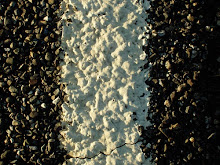Sean Talley creates works that look like prints, but are drawings—no, sculptures, really, made with very fine graphite dust. They look like this:

The edges are precise and the graphite reflective, dense, and deep. A wonder to behold, seeing into is nearly like looking into a still lake, a mirror and a depth both. That's the texture and it isn't actually deep—a thin layer, a millimeter, perhaps, of particles pressed into, onto the paper, yet, like space, deep and resonant.

He's made shapes and grids, but for this show the stand-outs are one-corner-missing pieces in graphite and plaster.

Anyone who's worked with plaster knows that, like graphite, plaster too is a fine dust. The gypsum packed tight in the drying process, remains powdery though, to the touch. How curious that the white plaster is dull and the black graphite reflective, the reverse of what we think of as the properties of light and dark.
Using "unassuming materials and refined processes" is such an apt way to describe his work. Subtle and pure—and I am tempted to touch them, which, of course, would spoil the whole effect.
